Foundation of the WAVES
.
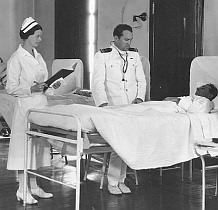 Navy doctor and nurse in
the U.S. Naval Hospital, Washington, D.C. during the 1930s
Navy doctor and nurse in
the U.S. Naval Hospital, Washington, D.C. during the 1930s
|
..... |
The only women allowed to serve in the Navy
before World War II were nurses, with one important exception.
During World War I, women had filled several
different jobs formerly reserved for men, but this limited female progress
was terminated immediately after the wartime emergency ended (see US
Navy in World War I ).
The only accepted role for women in the Navy
remained as nurses. |
.
| However, the situation in the Navy changed
soon after the Japanese attack on Pearl Harbor in December 1941, which
brought the United States into total war. The Navy faced an overwhelming
shortage of personnel for its rapidly expanded mobilization.
The availability of dedicated and qualified
women was seen as an expedient new wartime measure that could place men
in the “fighting fleet”, by filling all possible noncombatant jobs with
female volunteers in their place. |
..... |
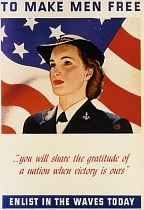 |
.
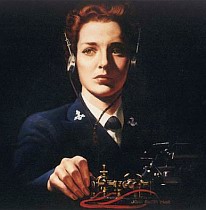 WAVE Radio Operator
WAVE Radio Operator
|
.... |
The situation thus forced the Navy to call
upon the services of available military-fit women. Female personnel were
especially desired for critical support roles, such as the important naval
communications network.
Such jobs could not be filled by male civilians
because of the military nature of the duty and the secrecy requirements
involved in national defense. For instance, the handling of vital military
messages required military-type security clearances. |
.
An Advisory Council, later known as the Advisory
Educational Council, was established to plan for the contingency of women
serving the Navy, and continued to function throughout World War II:
Council Members
.
 |
.. |
Miss Mildred McAfee
President of Wellesley College |
|
 |
.. |
Miss Virginia C. Gildersleeve
Dean of Barnard College |
|
 |
.. |
Miss Ada Comstock
President of Radcliffe College |
|
 |
.. |
Mrs. Thomas S. Gates
Wife of the President of the University of Pennsylvania |
|
 |
.. |
Miss Meta Glass
President of Sweet Briar College |
|
 |
.. |
Miss Alice M. Baldwin
Dean of Women's College, Duke University |
|
Miss Alice C. Lloyd
Dean of women, University of Michigan |
Mrs. Malbone Graham
Professor, author and lecturer of Santa Monica,
California |
.
This council decided that a Women’s Reserve
Corps was urgently needed as a component of the Navy because of personnel
accountability, military proficiency and other unique service needs that
civilians could not meet. The Navy demand for its own corps of woman volunteers
also represented an important and novel step forward, since the Women's
Auxiliary Army Corps (which was established 6 months before the WAVES law
passed Congress) had not yet been granted military status.
.
| Legislation was needed to permit women to
serve in an official capacity. Rapid military expansion required the Navy
to transfer male sailors, wherever confined to shore jobs, as crews for
the huge number of projected ships. This could only be done by replacing
manpower ashore with womanpower.
House Resolution 6807 was introduced in Congress
on March 18, 1942, to amend the Naval Reserve Act of 1938 by including
an organization to be known as the "Women's Auxiliary Reserve." Less than
a month later, on April 16, 1942, the House Naval Affairs Committee reported
favorably on this resolution. |
.... |
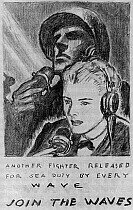 |
.
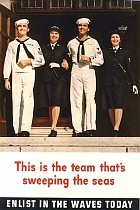 |
.... |
Despite the emergency, details of the idea
were debated for the next four months by the men in Congress. The main
problem was whether women should serve merely with the Navy, or actually
in the Navy.
It was grudgingly decided that females could
serve in the Navy (that is, as an actual part of it), but on a strictly
experimental basis. More objections were overcome by renaming the "Women's
Auxiliary Reserve" as the "Women's Reserve" and changing proposed requirements
as to age, education, and other matters. |
.
| Restrictions on rank were emplaced to insure
only 1 lieutenant commander, 35 lieutenants and that no more than a third
of the officers could be lieutenants.
Finally, on June 24, this legislation was passed
by the Senate and approved by the House of Representatives. It was sent
to President Roosevelt on July 21, and he signed the legislation into law
on July 30. |
.... |
 Franklin Delano Rooselvelt
Franklin Delano Rooselvelt
|
.
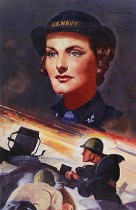 |
.... |
The term WAVES for this newly established
women’s organization was chosen as an abbreviation for "Women Accepted
for Volunteer Emergency Service."
The WAVES were intended to fill vacated and
newly created positions within the Navy shore establishment, allowing male
sailors to be displaced forward or aboard ships. The Navy did not want
to put women into its combat sea or air squadrons. Women were not to be
assigned to Navy ships, except for hospital ships, or aboard aircraft,
except for planes devoted to medical care and evacuation purposes. |
.
The first Director of the Women’s Reserve
was a former member of the Advisory Council and President of Wellesley
College, Miss Mildred H. McAfee (who later became Mrs. Douglas Horton).
.
| She was directly commissioned as a Lieutenant
Commander on 3 August 1942, and given the task of leading the WAVES. In
November 1943, provisions were made for one officer over the Women's Reserve
in the temporary rank of Captain and she was promoted.
Captain Mildred McAfee Horton, USNR, served
as Director of the Women's Reserve until February 1946, when she left the
service and went back to Wellesley College. She was replaced by Captain
Jean T. Palmer, USNR. |
.... |
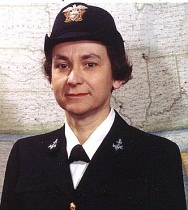 Captain Mildred H. McAfee,
USNR
Captain Mildred H. McAfee,
USNR
|
.
.
[ I. Development ]..[
II. Facts about the WAVES ]..[
III. Uniforms ]..[
IV. Sources ]
|
